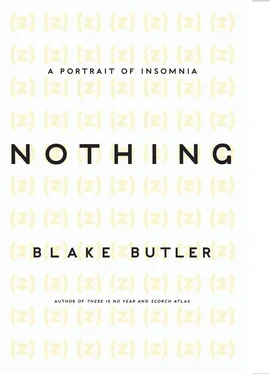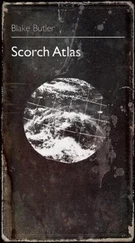What Not Sleeping Starts To Make
And I also have no name, and that is my name. And because I depersonalize to the point of not having a name, I shall answer every time someone says: me.
Clarice Lispector
For several years between the ages of eight and twelve, I saw the same dream every night. The trick about the dream is that I was not dreaming, or asleep. The vision was of my room. In the vision I lay in my bed the way I did when waking, in my blue bedroom in the half bunk bed with the head end against the wall. From in the bed I could see above me a large stone boulder hung in the ceiling, through our home’s roof, lying lodged. The boulder was large as half of my whole room was, and seemed to negate any air. I mean in the room I was not breathing, and did not need to. I could not close these second eyes behind my eyes.
Each night, the boulder rolled. I could feel it edging forward slightly in its dark mass, so slow that it almost seemed not to move at all. There was a low sound to the grinding, its frame against the house’s frame. Over hours, the boulder would roll toward me looming, approaching closer and closer to my head. During this whole time I could not move my arms or legs or blink my eyes at all. I could not force myself to come back fully into wake, nor could I lapse deep enough into the nothing that there was nothing I could see. I could not unlock myself from watching, through the whole night, as it came forward, end over end, the space between us slowly pressing, growing closer inch by inch. Soon it would be so close above me I could feel it breathing where I wasn’t, its face the only element left in my sight. It would grow and grow there, just above me. It would be a yard away, and then a foot. Then it would be right there eye to eye against me, like some whole shapeless sky just at my face — a gray and endless thing with sound inside it. Nowhere . Up close the sphere had the same texture as it did from far away, hazy and cut with long lines.
The dream ended the same way every time. Having spent the duration of the night in hellish approach, there would at last be nearly no distance left between us. There would come a point where if the boulder rolled even one slip further, it would come against me, touch my skin. There was the clear threat of becoming crushed. Then, just as that last increment, which would end me, continued rolling, I would wake up again in my bed — waking in the same room where I had been during sleeping, though with the boulder no longer there, our home’s ceiling and the air beneath it again intact, an unbroken clean white surface holding out the night, complete with the fake, yellow nightglow stars I’d assigned above me like so many other kids then, in patterns to replicate the sky outside.
I did not wake with a start inside these moments, or with quick inhale, but just with a simple blink, returned. It might by then have become morning, or sometimes only several hours had gone past, and yet each time it seemed as if inside my sleep I’d gone through many days. Some nights the night would seem to have lasted longer than I’d been alive already, and yet I had not aged, as far as I could tell. My waking body always felt the same — as if I’d left it and returned there, leaving the time under the boulder somewhere else, or perhaps crammed into a crater on my inside, another wormhole in my brain. In this way time could become split: living longer inside these packets of my brain and body, if in pure torture, while on my flesh the days held human days — a space there captured between instants of the human, elongating in some fold beneath the conscious. In another way, this time extends eternal — I’ve never quite been able since then to shake the image of the boulder there above me, the slow grind of its low light — it is always in me — where?
After the first few times the dream repeated, I remember beginning to feel a great sense of impending anxiety about my bedtime. Into the late evening, hidden in my bedroom, I would try to stay conscious longer, to stay on, consuming my brain with reading or watching TV. I recorded tapes of myself reading books aloud — a practice installed in me at an early age by my mother — and would play them looping by my bedside to try to keep even my sleeping brain distracted. Not quite a violent and insistent need to avoid the dreamworld, as in the Nightmare on Elm Street movies, where the sleepers are literally staying awake to avoid young death, but more a growing fear of the sleep state itself — ever the boulder, and its impending visitation.
Though the boulder seemed the beginning of the presence of recursion and strange noise in my sleep patterns, from here further the sleep disruption quickly spooled. The evenings peeling forward from this period hold stored in my mind not as a string of sequential hours, but as anomalies and drifts. Most nights awake alone seem to blend together, making one enormous long night of their thread. A single sky the blank of waking makes of darker hours spent not sleeping in or around the house or bed. Many nights from there on, under the boulder, seen or unseen, inside my own home’s version I would stay awake for hours fearing the idea of what would happen to our house when my eyes would close. It could seem as if, at every second I was not seeing, the house would fill with silent strangers, standing above me, their mouths or other parts just inches from my eyes. Behind my eyes, where colors spun from how I put pressure on them holding my lids down hard as I could, the house would shift with sound and things between it. I did not want to have to look. And yet I had to look, and when I would there would be nothing. The room went on being a room. The hallway led on from my door into another. There were all these places they could hide. There was so much to see and hear for in not hearing. Every inch potential. Every light both a mirage and a guide, spooling outward into something, ever larger.
In her essay “Every Exit Is an Entrance (A Praise of Sleep),” Anne Carson describes her own experience of appearing in a dream of her childhood living room. In the dream she awakes in her sleeping bed and rises, goes downstairs to find that familiar space left with its lights on, composed so “nothing was out of place. And yet it was utterly, certainly, different. Inside its usual appearance the living room was as changed as if it had gone mad.” Gone mad , she writes, this room was, this living room , the space often most familiar to the habited motions of a family. The sense of the room’s psionic reorchestration is evident only by its impression on her body, its image returned and altered by what she herself had felt or done inside the room, recurred. Carson’s memory here serves her not as an object of terror or unveiling, but instead it is as if the room itself had been asleep, as if the air and outline of this room she no doubt came and went from daily in her sleep mind had a mind too, a consciousness, even, perhaps. Confronted in this brain field, Carson finds the room’s shape “supremely consoling… sunk in its greenness, breathing its own order, answerable to no one, apparently penetrable everywhere and yet so perfectly disguised in all the propaganda of its own waking life as to become in a true sense something incognito at the heart of our sleeping house.” Through her sleep’s eye, where the room has amassed around her, Carson learns to see her life anew from strange angles, to find comfort in a terrain that might no longer be accessible through her body, but that herein exists in cells awakened in her conscious mind’s release — access to terrain upon a map that connects to no concrete door, but a button in the head — one that, once aware of, one might find it harder or more fraught to interact with, or to reckon — the door to sleep now not a simple door, but one with many different kinds of locks and peepholes, eyes.
Читать дальше












